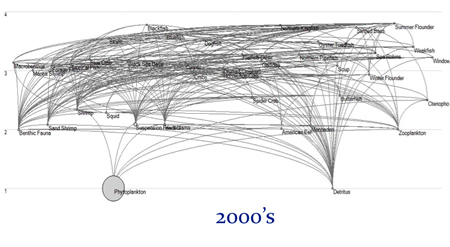Michael Frisk, Robert Cerrato, Mattew Nuttall
Mass balanced models yield valuable information regarding ecological function and delivery of ecosystem services, but often rely on data collected well before many species were reduced to fractions of their original abundance. Lagoonal systems, such as Great South Bay (GSB), NY, sit on the interface of terrestrial and marine ecosystems and are prone to anthropogenic stressors but proximity to land also makes the presence of data regarding historic populations and structure more likely. To quantify over a century of ecosystem change, Ecopath models were developed for GSB at each of four time periods where commercial and scientific data exist: 1880s, 1930s, 1980s and 2000s. The results indicated that the GSB has experienced a decline in ecosystem maturity, loss of top keystone predators, a decline in connectivity to the ocean though a reduction of migratory species and an increasing dominance of low trophic level organisms. These changes undermine the delivery of ecosystem services, increase conflicts over limited resources and suggest that present day restoration targets fail to recognize appropriate baselines. Further, maintenance of lagoonal physical structure by shoreline modification and dredging of inlets has removed an important characteristic in the periodic renewal and reworking of physical dynamics through storm induced breaches of barrier islands.





